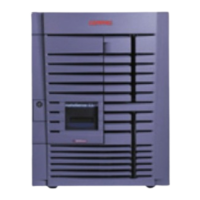Using the Remote Management Console 7-3
The RMC logic is implemented using an 8-bit microprocessor, PIC17C44, as the
primary control device. The firmware code is resident within the microproces-
sor and in flash memory. If the RMC firmware should ever become corrupted or
obsolete, you can update it manually using the Loadable Firmware Update
Utility. See Chapter 3 for details. The microprocessor can also communicate
with the system power control logic to turn on or turn off power to the rest of
the system.
The RMC is powered by an auxiliary 5V supply. You can gain access to the
RMC as long as AC power is available to the system (through an AC outlet).
Thus, if the system fails, you can still access the RMC and gather error/fault
information about the failure.
DPR Error Repository
The RMC manages an extensive network of FRU I
2
C EEPROMs. Information
from these EEPROMs is stored in dual-port RAM (DPR)—a shared RAM that
facilitates interaction between the RMC and the system—and can be accessed to
diagnose hardware failures.
At system power-up, the RMC reads 256 bytes of data from each FRU EEPROM
and stores it in the DPR. The EEPROM data contains information on
configuration and errors. The data is accessible through the TIG chip on the
system motherboard.
As one of its functions, the TIG provides interfaces for the firmware and the
operating system to communicate with the server management logic. The data
accessed from DPR provides configuration information to the firmware during
start-up. Remote or local applications can read the DPR system error and
configuration repository. The error log information is written to the DPR by an
error handling agent and then written back to the EEPROMs by the RMC. This
arrangement ensures that the error log is available on a FRU after power has
been lost.
The RMC console provides several commands for accessing error information in
the DPR. See Section 7.6. Compaq Analyze, described in Chapter 5, can access
the FRU EEPROM error logs to provide diagnostic information for system
FRUs.

